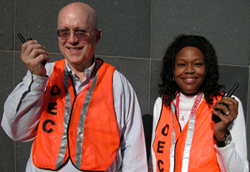Are You Ready?
Emergency Preparedness Plans for NIH Workers Take Shape |
| By Belle Waring |
| |
 |
 |
 |
| |
NCI’s Dr. John Cole (l) and Robin Brown are OECs—occupant evacuation coordinators— at EPN in Rockville. |
Crazy things happen—fire, flood, anthrax—therefore we plan. Preparedness is part of the NIH mission; it is also a mindset to which everyone contributes.
Mike Spillane, director of the Division of Emergency Preparedness and Coordination
(DEPC), describes being prepared as “not specifically about terrorism—it’s about things we know will happen. If we prepare for them, then we can cover the unknown.” DEPC crafts emergency plans for all NIH facilities, both on and off campus; maintains shelter-in-place/evacuation plans; and develops responses, alerts, notification procedures
and drills. The division also manages the NIH Continuity of Operations Plan, or COOP, which includes the PanFlu Management Plan (see NIH Record, Oct. 6, 2006).
Spillane’s turf includes the Bethesda campus with almost 18,000 workers on 306 acres as well as four other sites in the metro area (the leased space at Executive Blvd., Rock Spring Park, Twinbrook and Bethesda count as one site). These off-campus sites hold a total workforce of over 12,000. He also manages an automated communications system for voice and text messages to send alerts to NIH leadership and emergency coordinators within each institute and center.
more…
|
|
|
To Fe or Not To Fe?
Iron Replacement Study at Blood Bank Is a First |
| By Belle Waring |
|
You don’t miss your water ’til your well runs dry. As for your blood, it is your intrinsic well, your internal sea, bathing every cell with oxygen.
So unless there’s a problem, you may take it for granted. But Dr. Barbara Bryant surely doesn’t. As a clinical fellow in the Clinical Center
department of transfusion medicine, she is principal investigator in the Iron Replacement or Not (IRON) study, which tackles iron depletion
in the blood-donor population.
“As far as I know,” Bryant says, “we are the only blood bank in the U.S. to do this”—to examine the safety and efficacy of giving donors oral iron supplements (a.k.a. Fe, the chemical symbol from the Latin ferrum).
more…
|
|
|
|

